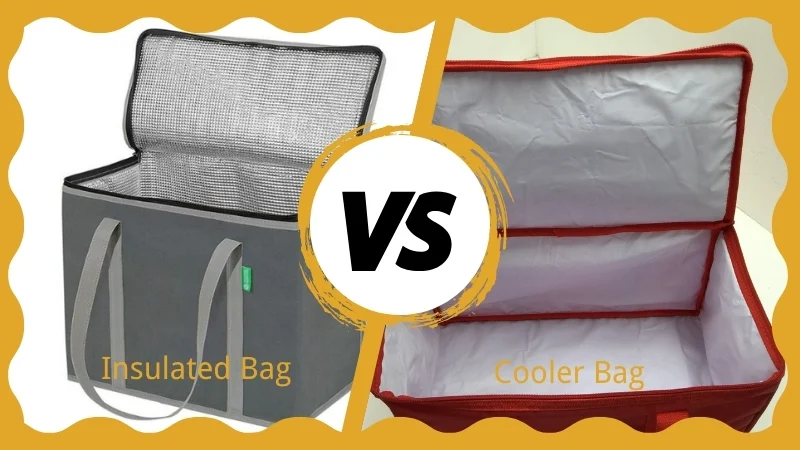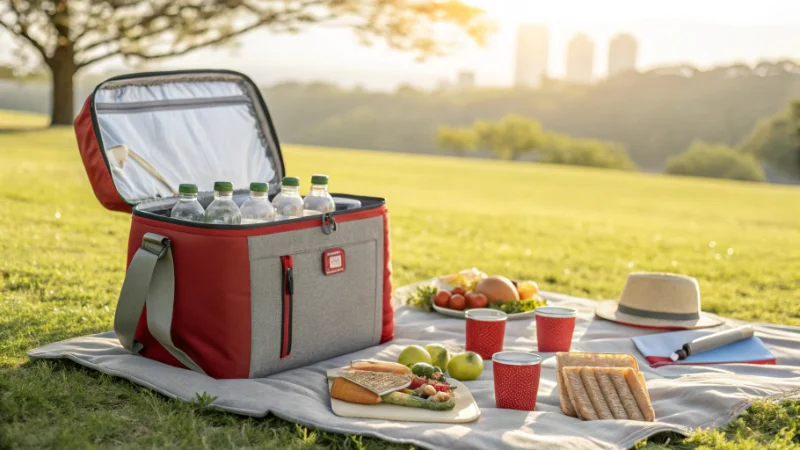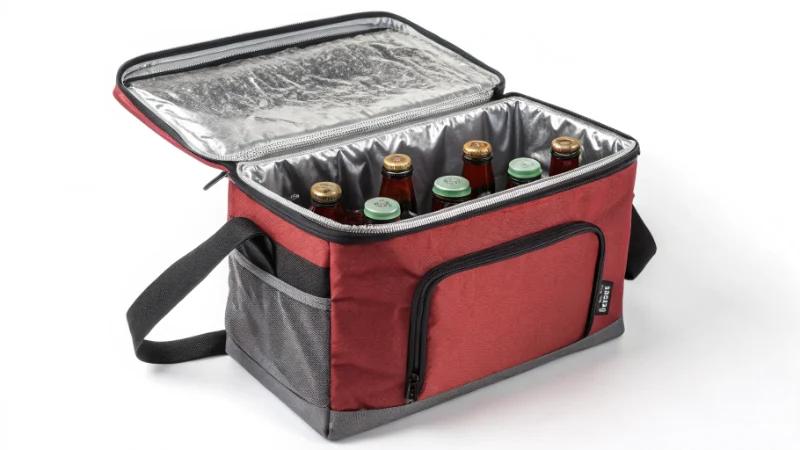Our Academy

Ever found yourself confused between “insulated bag” and “cooler bag” when shopping for a thermal food carrier? At first glance, they seem alike—but choose the wrong one, and your food might warm up, fruit lose its freshness, or worse, your entire trip gets ruined.
Insulated Bag vs Cooler Bag: What Are the Key Differences? While both bags provide thermal insulation, they differ significantly in structure, usage, and cooling performance. Insulated bags are lightweight and commonly used for lunches, food delivery, and grocery shopping, making them suitable for short-term hot or cold storage. Cooler bags, in contrast, feature thicker foam insulation and more durable outer materials, often paired with ice packs for extended cold retention—ideal for picnics, camping, and outdoor use. The former prioritizes portability and everyday convenience, while the latter is designed for higher capacity and longer cooling duration. Choosing between them depends on your intended use time, frequency, and storage needs.
We’ve just covered the high-level differences. But when you look at different materials, structures, and actual usage environments, the line between the two becomes more nuanced. Read on for a detailed breakdown of their cooling mechanisms, material construction, typical applications, and how to choose the right bag for your needs.
Cooler bags are generally more durable than insulated bags. True
Cooler bags often use thicker outer fabrics like Oxford cloth or canvas and reinforced stitching for better durability.
Cooler bags are usually smaller and more compact than insulated bags. False
Both cooler bags and insulated bags can be customized in size, but in general, cooler bags are bulkier due to thicker insulation and are often designed for carrying more items over longer periods.
A cooler bag is a type of insulated container specifically designed for extended cold retention. It features a thicker layer of foam insulation at its core, a more durable outer shell typically made of oxford cloth or canvas, and an inner lining with a separate waterproof layer—commonly PEVA or PVC—to prevent leakage from condensation. Cooler bags are often used with ice packs and perform well in scenarios requiring long-lasting refrigeration, such as picnics, camping, or long-distance transport. Compared to insulated bags, they place greater emphasis on cooling performance and structural durability, making them a preferred option for frequent outdoor use.

While both insulated bags and cooler bags offer some degree of cooling capability, they differ significantly in how long they can maintain low temperatures. Insulated bags are typically used for short-term transport or everyday food preservation, with an average cooling time of 2 to 4 hours. When combined with ice packs and properly sealed, they can keep items cold for up to 6 hours, making them suitable for commuting, lunch packing, or local deliveries. Cooler bags, on the other hand, feature thicker foam insulation and better sealing, allowing them to maintain low temperatures for 6 to 12 hours. Some high-performance models can even exceed half a day under ideal conditions, making them ideal for extended outdoor activities or long-distance cold chain transport.
Compared to typical insulated bags, cooler bags generally offer larger capacity and better load-bearing capability. They are more suited for family outings, group gatherings, or situations requiring prolonged cold storage. Insulated bags, by contrast, are usually designed in smaller sizes, ideal for carrying lunch, a few drinks, or for everyday grocery shopping. While neither type has strict size limitations, cooler bags are more often found in medium to large formats, whereas insulated bags focus on portability and easy storage—better aligning with the pace of urban lifestyles.
Insulated bags typically feature an outer layer made of lightweight nonwoven fabric or polyester. Inside, a thin layer of EPE foam is combined with a reflective aluminum film to provide basic insulation performance. These bags prioritize portability and functional lightness, making them easy to store but less focused on durability or long-term thermal retention.
Cooler bags, in contrast, are designed for improved durability and extended cooling performance. Their outer layer is usually made of heavier-duty materials such as Oxford cloth or canvas with denser weaves. The middle layer uses thicker PE foam for better insulation, while the inner lining often includes waterproof materials like PVC or PEVA to prevent condensation from leaking. Overall, the structure is bulkier and more robust, tailored to environments where stronger cold retention and water resistance are needed.
| Component | Insulated Bag | Cooler Bag |
|---|---|---|
| Outer Material | Lightweight fabrics like nonwoven or polyester | Thicker woven materials like Oxford cloth or canvas |
| Insulation Layer | Thin EPE foam + aluminum reflective layer | Thick PE foam for enhanced cold retention |
| Inner Layer | Aluminum film directly applied, rarely waterproof | Waterproof liner (PEVA/PVC) to block condensation |
| Overall Structure | Thin, lightweight, easy to store | Thick and sturdy, ideal for extended cooling use |
Insulated bags are well-suited for daily situations that require short-term temperature control, such as carrying lunch to work or school, grocery shopping, or short-distance food delivery. Their lightweight build and flexible use make them ideal for frequent opening and carrying.
Cooler bags are more appropriate for scenarios that demand longer cold retention, such as outdoor picnics, camping trips, or long-haul transport. When used with ice packs, they offer extended cooling duration and are better suited for high-temperature environments or longer storage needs.

| Use Case | Insulated Bag | Cooler Bag |
|---|---|---|
| Work/School Lunch | Lightweight and easy to carry | Usable, though some models may be bulkier |
| Grocery Shopping | Good for daily chilled purchases | Also suitable, better for prolonged cooling |
| Short-Distance Urban Delivery | Commonly used for brief temperature control | For orders needing more stable cold storage |
| Outdoor Activities (Picnic/Camping) | Limited cooling time, best for short trips | Thick structure, suitable for longer outdoor stays |
| Long-Term Cold Transport | Not recommended | Durable and ideal for long-distance or intercity transport |
Both cooler bags and insulated bags use thermal materials to maintain temperature. True
Most of these bags include insulating layers like foam or aluminum film to reduce heat exchange.
Insulated bags always include a hard plastic shell inside. False
Insulated bags are typically soft-structured and do not contain rigid frames unless specially designed.
When it comes to portability, insulated bags and cooler bags each offer unique advantages depending on the usage scenario. While size can vary across both types, insulated bags are generally made from thinner, lighter materials, making them easier to carry and fold for storage. Some models are also available in large-capacity formats, suitable for grocery shopping and daily errands.
Cooler bags, on the other hand, are built with thicker layers and slightly heavier materials, which adds to their weight. However, many designs include handles, shoulder straps, or backpack-style features that enhance portability during travel. Both bag types can be customized in a range of sizes, and the best choice often comes down to material preferences and functional needs.
| Feature | Insulated Bag | Cooler Bag |
|---|---|---|
| Material Weight | Lighter and easier to carry | Slightly heavier, often with carry-friendly designs |
| Foldability | Easily foldable and compact | Bulkier, takes up more space when stored |
| Size Flexibility | Available in various sizes, including large | Often mid-to-large capacity for group use |
| Everyday Convenience | Ideal for work, shopping, short trips | Suited for planned outdoor or travel use |
When it comes to cost, insulated bags are generally more affordable than cooler bags. They are well-suited for budget-conscious projects or as promotional giveaways. Their simpler structure and lightweight materials help keep unit prices low, making them ideal for bulk customization.
In contrast, cooler bags tend to be more expensive due to their thicker foam insulation, more durable outer materials, and more complex manufacturing processes. They are better suited for customers who prioritize stronger cooling performance and product quality—especially in outdoor activities or branded promotional campaigns where a higher standard is expected.
In some light-use scenarios, insulated bags and cooler bags can indeed be used interchangeably. For example, when carrying cold drinks or lunch for a short period, a thermal bag combined with ice packs can provide basic cooling performance. However, their structural differences—such as insulation thickness, waterproofing, and intended cooling duration—make them unsuitable for full substitution. If you expect to use the bag for more than 6 hours, or in demanding conditions like outdoor heat or long-distance transport, it’s best to choose a cooler bag with sturdier construction and more reliable insulation.
In addition to time, the environment also plays a role. For mild or shaded conditions, an insulated bag can easily handle basic cooling tasks. But in harsher settings—such as high temperatures, direct sunlight, or outdoor activities—you’ll want a cooler bag with stronger insulation. Pairing it with ice packs can further enhance cooling duration and help prevent spoilage.
If you’re on a budget or only need basic, short-term thermal protection, an insulated bag is a more cost-effective choice. It’s lightweight, practical, and less expensive to produce. However, if you require longer cooling performance, better waterproofing, and greater durability, investing in a cooler bag makes more sense. Their structural and material differences also reflect in price, so it’s best to choose based on actual usage needs rather than price alone.

Cooler bags are suitable for long outdoor activities like camping or beach trips. True
Thanks to better insulation and structure, cooler bags can preserve cold temperatures for extended periods.
You cannot use cooler bags for hot food storage. False
Cooler bags can also retain warmth for short periods if packed properly with hot food.
In summary, while both insulated bags and cooler bags belong to the same category of thermal bags, they differ significantly in structure, cooling duration, materials, and suitable applications. Insulated bags focus on being lightweight and are ideal for short-term use, such as commuting, shopping, and food delivery. Cooler bags, on the other hand, offer enhanced insulation and durability, making them more suitable for long-term cooling, outdoor activities, or complex transportation needs. When choosing between the two, it’s important to consider usage time, environmental conditions, functional requirements, and budget to avoid performance issues caused by the wrong bag type. By understanding the key differences, users can make more targeted decisions and choose the right bag to improve convenience and achieve better cooling management.
If you’re looking for a thermal bag solution for outdoor events, food delivery, or promotional use, Yanxin Bag offers professional bulk customization services. As an experienced cooler bag manufacturer and insulated bag factory, we provide a wide range of custom insulated bags and custom cooler bags, available in various structures, materials, and printing options. Our products are widely used for lunch carrying, outdoor travel, and fresh food transport.
Feel free to contact Yanxin Bag to explore thermal bag solutions that align with your brand goals and functional needs.
Curious about how insulated lunch bags really keep food hot or cold? Explore our full breakdown here: Insulated Lunch Bags: The Secret to Keeping Food Hot or Cold
Answer: Cooler bags are better for long-term cooling in outdoor settings. They feature thicker insulation and more durable construction, making them ideal for picnics, camping, and long-distance transportation.
Answer: Insulated bags typically use lightweight materials like non-woven fabric, thin foam, and aluminum foil. Cooler bags, on the other hand, are made with oxford cloth, thick foam, and waterproof linings, offering greater durability and insulation.
Answer: Yes. Insulated bags are cost-effective and suitable for short-term use. They are ideal for lunch carrying, food deliveries, and promotional giveaways due to their lower production cost.
Answer: Hard coolers offer longer cooling duration and more structural strength, while soft cooler bags provide better portability and branding flexibility.
Answer: It’s recommended to use ice packs or sealed ice containers to prevent leaks, unless the cooler bag has a heat-sealed PEVA or PVC lining.
Answer: Soft cooler bags are more portable and customizable, while hard cooler boxes are rigid, offer longer ice retention, and are better for extended outdoor use.
Answer: Yes. Insulated bags can keep food warm as well as cold, making them suitable for transporting soups, hot meals, or takeaway dishes over short periods.
Answer: To clean reusable cooler bags, wipe the inner lining with a damp cloth or mild detergent. PEVA and PVC linings are easy to maintain due to their waterproof surfaces. Avoid machine washing unless specified. Proper care extends the life of custom cooler bags and maintains their insulation performance.
Answer: Cooler bags can maintain temperature for a short time without ice packs, but for optimal insulation performance, using ice packs is strongly recommended.


Your Shopping Bag Expert
Order or no-order we are Always here to help you!
We will contact you within 1 working day, please pay attention to the email with the suffix “@yanxinbag.com”.
Order or no-order we are Always here to help you!
We will contact you within 1 working day, please pay attention to the email with the suffix “@yanxinbag.com”.